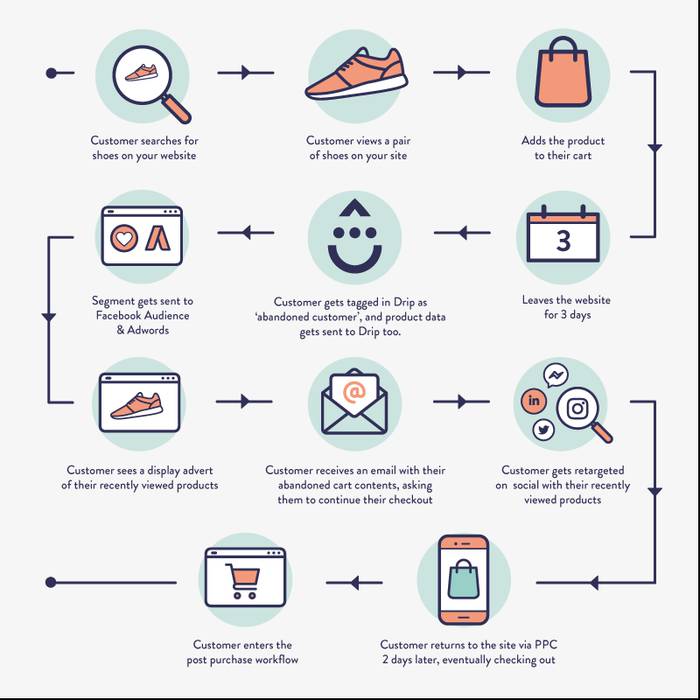Get your toolkit in order
Behavioural marketing is reliant on a number of different platforms and tools to talk to one another. Fundamentally we tend to concentrate on these main areas and then add further interactions and segmentations along the way.
- Website interaction - product & search history, product and category interaction, basket abandonment, onsite interaction etc.
- CRM - invoicing, address, account access, recent contact, credit status etc.
With that said, it’s important to think about your toolkit. We’d always advise on building any and all marketing activity around your business objective. Having this in place means you will be able to help determine the tools and tactics required.
For example, if you’re a global ecommerce company with multiple data points that all have to stay in sync and share the data simultaneously, you may wish to use something like Segment to help streamline your data collection methods, and have that handle the distribution of your data to your respective tools.
For the large majority of our clients, we use a combination of Drip, Google Tag Manager and Google Analytics.
Drip as our go to tool for organising our data that builds personas and profiles around individual interactions.
Google Tag Manager to actually push that Data to Drip and Google Analytics. It’s an eCRM that helps tie everything together. With this in place, we can see how people are interacting with our clients and gain valuable insight to create automations across all marketing channels.
There are elements you can carry out yourself if you're comfortable dealing with code and events - however use your agency (developer) to help support you with this.
“Your overarching campaign objectives will dictate what data you collect...”
Revisit your objectives
Have a proper understanding of what you want to achieve from behavioural marketing. Your overarching campaign objectives will dictate what data you collect, and how you use it. Don’t be greedy, only collect what you’re going to use, otherwise you start dipping your toes in the pool of creepiness and start violating people's privacy.
Ask yourself the following questions to help understand exactly what you need:
- What data am I currently missing?
- What do I want to achieve from implementing a behavioural marketing campaign?
- How am I going to measure the success of this?
- What information do I already have available, and what extra information do I need?
- Can I actually collect this information? If so, how do I go about doing so.
- What are your timeframes? Depending on the complexities of what you want to achieve and the resources required, this could take anything from days to months to get in a usable position.
Behavioural marketing is a multi-channel and multi-touchpoint process.
As we’ve mentioned in our previous articles, a good behavioural marketing campaign shouldn’t be isolated to just email marketing. Your other channels such as Social Media, PPC and Programmatic Display campaigns should all be working in cohesion to ensure that you’re using your newly available data to provide consistent messaging and context to your customers (right message at the right time).
How do you go about doing this?
Well, the most basic way of achieving this is to make sure that all your different teams are communicating to one another. For example, by ensuring that your social and paid search team are talking to one another, along with your design team, you’ll immediately be in a position where your creative and content is all consistent across different platforms, online and offline.
You can take this a step further by using something such as Drip, as it allows you to share data across platforms automatically. For example, you can share the contents of a specific segment created in Drip with Facebook, so that your audiences in Facebook mirror that of your email marketing list.
You could then export this data from Drip, and use it as customer match data in Adwords to allow you to retarget based on email address data, or build lookalike audiences from it to identify other opportunities.
You can quickly start to see the benefits of sharing the data across your other channels. Not only does it provide a better experience for your customer, it means there is no duplication of work across different departments. If they’re all working off the same data set, then there’s no need for manual audience creation on each respective platform, where you then run the risk of having conflicting audiences.
Measure success and then scale your operations based on performance.
This should be an approach that is adopted across any marketing activity, and the same thought process should be applied with rolling out any behavioural marketing campaign. Once you’ve got things in place, run them on a small segment of your customer base and then review the performance over a 3 month period.
In regards to measurement, the metrics will be largely down to your objectives. However, some of the more common metrics to gauge success on for a lot of behavioural marketing campaigns could include:
- Customer retention
- Customer lifetime value
- Customers order frequency
- Customer purchase journey time
- Overall sales data
- Returning visits (in store and online)
- Open and click through rates
We use Google Data Studio to keep on top of all our metrics, as it provided a flexible and and scalable way of collating all our data into one place, automatically.
Test, and test again.
Once you’re confident you’ve got everything in place, it’s important to make sure that you’re 100% happy with the information that is being handled. This is one of the most important parts of this entire process. If you get it wrong and start muddling data between individuals, you risk opening yourself up to an onslaught of abuse and discreditation. Imagine showing the wrong information to individuals - it’s a marketers worst nightmare, particularly when you start collecting more personal information.
So make sure that it’s thoroughly tested in the same way you would with any website enhancement.
Need help getting your behavioural marketing up and running?
Get in touch todayPost by
Project




